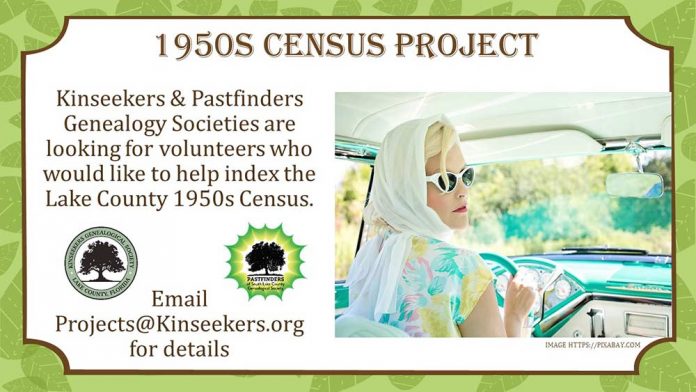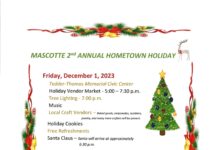Two Lake County genealogical societies are participating in FamilySearch International’s nationwide project to proofread computer-generated indexes of 1950 US Census entries for the county.

Kinseekers Genealogical Society, based in Leesburg, and Pastfinders of South Lake County, based in Clermont, are seeking volunteers to assist with the combined effort. “We are eager to help capture this important piece of Lake County history. This is a great opportunity for people interested in family history to share their time and talents,” said Roger Goddard, president of Kinseekers. “By completing this project, we will make it easier for local family historians to conduct research in Lake County,” said Anjanette Mercer, president of Pastfinders.
Because the census entries are handwritten, the computer-generated indexes may contain errors. As such, they require proofreading before the fully indexed versions can be made public through online databases.
Interested parties may send their contact information to projects@kinseekers.org .
FamilySearch issued the following information:
Through the 1950 US Census Community Project, FamilySearch is inviting online volunteers to assist in making the 1950 US Census easier for everyone to search and discover their family connections. This unique crowdsourcing project, easily the largest of its kind to date, will make the 150 million records of the individuals found on the census’s tens of thousands of online digital images searchable for free.
WHY THE 1950 US CENSUS?
The US Census collections are some of the most popular online databases used by millions of people for family history research. Most people in the US today can remember an ancestor who can be found in the 1950 US. Census.
As of April 1, 2022, the National Archives and Records Administration of the United States made digital images of the 1950 US Census available to the world. Protected by law for 72 years, this long-awaited census will be the most comprehensive record set available of those who were living in that historic era in the United States.The 1950 US Census Community Project is a national collaborative effort that uses the Internet, artificial intelligence, and a massive volunteer workforce to make these census records searchable online.
The outcome of this amazing initiative benefits everyone. Not only will every page of the 1950 US census be digitally preserved forever, but the general public will have convenient access to volumes of rich historical information that could provide the missing links to their own family histories.
WHAT KIND OF INFORMATION DOES IT CONTAIN?
The 1950 US census included the obvious questions such as name, age, gender, race, education, and place of birth. But the census also posed more detailed questions that will cast refreshing light on the preceding decade—which included World War II and the return of US troops. For example, those over age 14 were asked, “What was this person doing most of last week—working, keeping house, or something else?” and “What is the highest grade of school that the person has attended?”
Enthusiasm and interest in the 1950 census have been building steadily since the release of the 1940 census in 2012. These new records will introduce us to the 40,000,000 people born during this era of baby boomers. But this postwar decade wasn’t just prosperous for newborns. It also ushered in the civil rights movement, rock ’n’ roll, suburban living, and a wave of colorful innovations. Many of the powerful voices and inspired minds behind these changes will be found in the 1950 census.
The 1950 US Census Community Project is receiving additional support from Ancestry.com and leading societal organizations to engage and coordinate the volunteer workforce needed to deliver the ambitious 1950 US Census Project.
Although the 1950 US census is notably larger than the 1940 US census, thanks to advancements in technology, the anticipated help of online volunteers, and community support, the project is expected to be completed in a few months following the census’s release by NARA.










